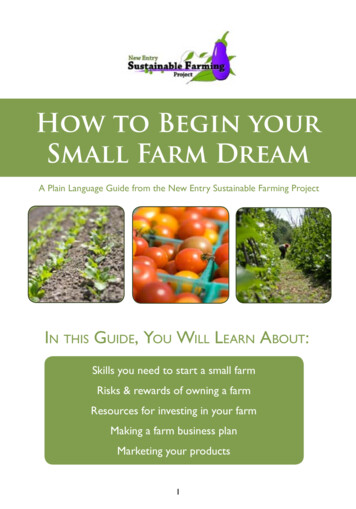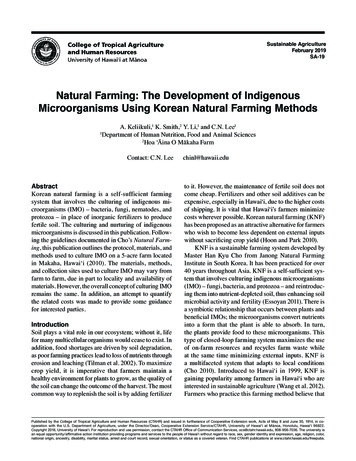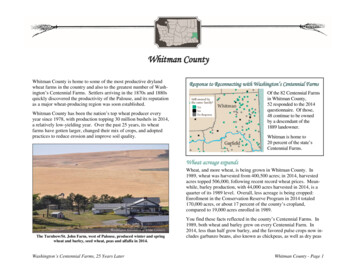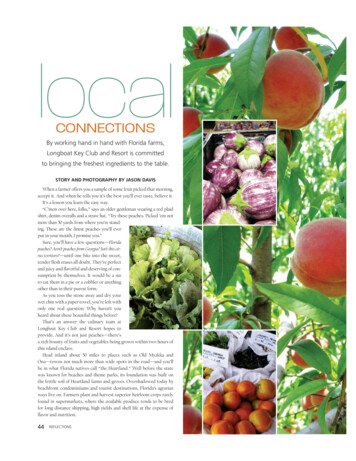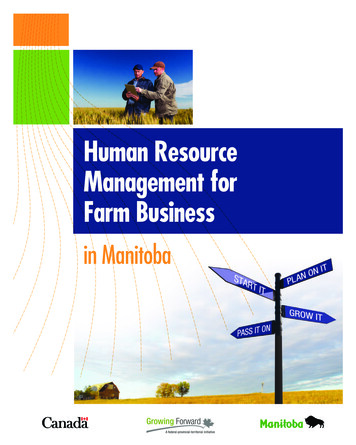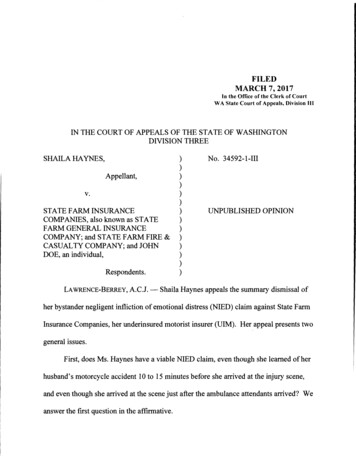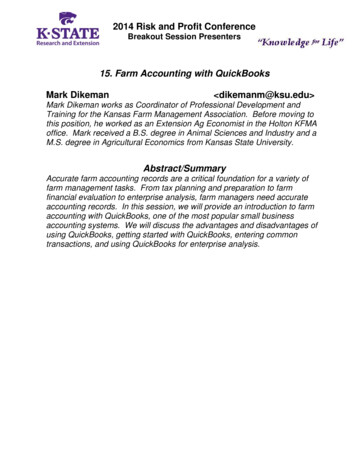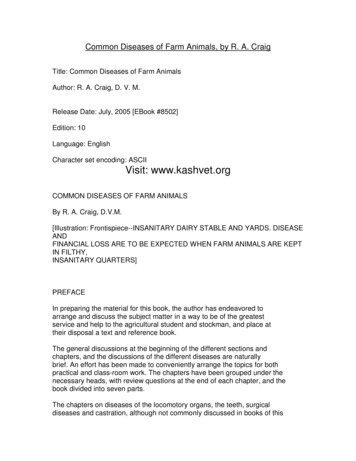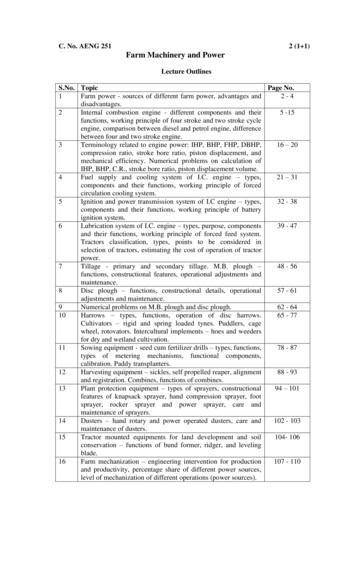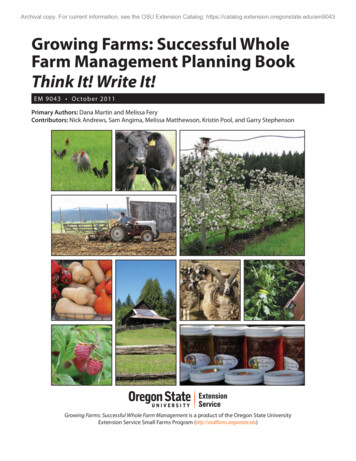
Transcription
Archival copy. For current information, see the OSU Extension Catalog: owing Farms: Successful WholeFarm Management Planning BookThink It! Write It!E M 9043 O c to b er 2011Primary Authors: Dana Martin and Melissa FeryContributors: Nick Andrews, Sam Angima, Melissa Matthewson, Kristin Pool, and Garry StephensonGrowing Farms: Successful Whole Farm Management is a product of the Oregon State UniversityExtension Service Small Farms Program (http://smallfarms.oregonstate.edu)
Archival copy. For current information, see the OSU Extension Catalog: ntentsDream It: Strategic Planning. 1Goals and Mission. 2Quality of Life. 5SWOT Analysis. 7Resource Inventory.10Grow It: oduction Techniques.20Integrated Pest Management.21Managing Soil Quality and Soil Fertility.23Do It: Farm Operations.24Equipment.24Energy Conservation .25Season Extenders.25Irrigation Efficiency.25Labor.26Technology.26Farm Resources.27Sell It: Marketing Strategies.28Personal/Lifestyle Considerations.28Product/Market Considerations.29Pricing.31Licenses and Special Permits.32Logo and Branding.33Manage It: Farm Finances.34Funding Opportunities.34Financial Statements.35Additional Thoughts to Consider.36Professional Services.36Keep It: Managing ial.38Business Structure/Tax Liability.38Farm Succession.38Whole Farm Planning Summary.39Inspirations.39Next Steps.39For More Information.inside back coverAbout the Authors.inside back coverAcknowledgments.inside back coverIntroductionGrowing Farms: Successful Whole FarmManagement is a workshop series that enhances thesuccess of new farmers by helping participants thinkthrough biological, physical, financial, and familyaspects of farm business. The workshops includeclassroom and field sessions, and topics follow anatural sequence, from planning through productionto long-term management. As participants progressthrough the Growing Farms series, their ideas aboutfarming and ranching as a lifestyle and businessbecome more focused.Growing Farms workshops cover six major topics: Dream It: Strategic Planning Grow It: Production Do It: Farm Operations Sell It: Marketing Strategies Manage It: Farm Finances Keep It: Managing RiskGrowing Farms PlanningBook: Think It! Write It!This planning book helps Growing Farmsworkshop participants process information andrecord ideas. It is a useful tool for exploring thoughtsand stimulating conversations during both self-studyand group discussion.Through questions and activities, participantsdevelop a better understanding of farmingenterprises and gain the skills necessary to assesstheir resources and develop a whole-farm plan.Through documentation and reflection, participantsbecome more definitive in their planning and arebetter able to discern dreams from reality.This planning book can also be useful for thosealready established in farm and ranch businesses,particularly if they are considering major changes.Photo credits:Tractor: Jerre Kosta Dodson, used with permission.Chicken, cattle, orchard, vegetables, barn:Melissa Fery, Oregon State University.Sheep, farm (back cover):Dana Martin, Oregon State University.Raspberries, cilantro, jam: Extension and Experiment StationCommunications, Oregon State University.
Archival copy. For current information, see the OSU Extension Catalog: eam It: Strategic PlanningFarm name: (may describe what you do, reflect your personality, provide marketing opportunities, refer toyour location, or be memorable)Owner(s)/operator(s):Members of farm team: (family members, key employees)Mailing address:Location address(es):County:Phone number(s):Fax number:E-mail address:Website:Dream It: Strategic Planning1
Archival copy. For current information, see the OSU Extension Catalog: als and MissionValuesA farm name, mission statement, and vision often include values. Values are core beliefs and philosophiesthat reflect your view on life. They often influence your goals and business decisions and help guidemanagement of your farm. Values typically do not change with time and are reflected in everything you do.List some of your values.Mission StatementA mission statement is a set of guiding principles based on your vision and values. It describes the overallpurpose of your business and may include what you do, how and why do you do it, and who you want toserve. Heartfelt mission statements are often used as marketing tools. Periodically review your missionstatement, and update it if necessary to keep your business dynamic.Write your mission statement or some key points that you will include in your mission statement.2Dream It: Strategic Planning
Archival copy. For current information, see the OSU Extension Catalog: ur Ideal FarmWhen you think about your current or future farm, what do you picture? Write a brief description of yourideal farm.Part of the planning process is learning new information. Look for this symbol throughout theplanning book. It reminds you to think about how what you are learning may affect your concept ofyour ideal farm.Here’s some room to record future revisions.QDream It: Strategic Planning3
Archival copy. For current information, see the OSU Extension Catalog: sionA vision statement describes the big picture of your business over time. It defines an ideal future and impactson your local community or society in general. Your vision may include what you want your farm to looklike in 10 years, what products you’d like produce, or how your farm will grow.Write your vision statement.GoalsGoals are short-, medium-, and long-term plans that align with your farm vision. Goals are more readilyachievable if they are SMART: Specific, Measurable, Attainable, Relevant, and Timely.List your short-term goals.List your medium- and long-term goals.4Dream It: Strategic Planning
Archival copy. For current information, see the OSU Extension Catalog: ality of LifeOwning and operating a farm offers a unique quality of life, some aspects of which may not be obviousduring the early planning stages. As part of your whole-farm planning process, think about the answers tothese questions. Suggestion: Have your farm partners answer these questions separately, and then discussyour answers.Do you like to mix your personal life and work life or keep them separate? Why?How valuable is having leisure time with friends and family?How much do you like working with others, including employees, family members, and business partners?Would you rather work by yourself?Do you enjoy marketing and having contact with customers? Why or why not?What are your favorite tasks on the farm (e.g., handling animals, production, or marketing)?(Quality of life questions continue on next page.)Dream It: Strategic Planning5
Archival copy. For current information, see the OSU Extension Catalog: proximately how many hours a week are you willing and able to work? Consider both on-farm andoff-farm work.Are you a risk taker? Are you comfortable with uncertainty, or do you prefer to know what to expect in mostsituations? Why?What does the phrase "financial security" mean to you?What are your family members’ goals and interests? How do they align with yours?What other demands are made on your time? Consider family, health, hobbies, and othertime commitments.Would you prefer to have family members perform all farm labor, or are you interested in hiringoutside help?6Dream It: Strategic Planning
Archival copy. For current information, see the OSU Extension Catalog: OT Analysis(Strengths, Weaknesses, Opportunities, and Threats)A SWOT analysis can help you identify obstacles and advantages of your farm or potential farm venture.First, identify each pro and con as a strength, weakness, opportunity, or threat (see examples below). Thenclassify it as internal or external to your business.This analysis helps you better understand what you can control, where your risks are, where improvementis necessary, and what direction is best for your business. This exercise is best completed with the entirefarm team.Strengths: Knowledge, communication, and prior experiences of your farm team Infrastructure Water rights Certification EquipmentWeaknesses: Limitations of your land (e.g., climate, soil type, and water access) Lacking or dilapidated infrastructure and equipment Lacking or negative characteristics of your farm teamOpportunities: Demand, market niches, and access to markets Grant opportunities Education programs and other resourcesThreats: Rising input costs (out of your control and can threaten profitability) Lack of access to laborNotes:Dream It: Strategic Planning7
Archival copy. For current information, see the OSU Extension Catalog: ample SWOT analysis:StrengthsInternalWeaknessesInternal Prior business experience Barn is beyond repair and needs to be rebuilt Good communication between partners Land is in a frost pocket Land is organic certified Partners have no mechanical experience Water rights available for irrigation waterOpportunitiesInternal Have personal connections with two local chefsExternal8 Local demand for organic produce New local-food-oriented supermarket being built innearby townDream It: Strategic PlanningThreatsExternal Rising fuel costs Lack of employable labor Increased number of small farms in vicinity(competition?)
Archival copy. For current information, see the OSU Extension Catalog: mplete a SWOT analysis of your farm, considering internal and external am It: Strategic Planning9
Archival copy. For current information, see the OSU Extension Catalog: source InventoryLandLegal description of farm:Township:Range:LandAcreageSection:Water rightsCommentsTillable landPastureWoodlotOtherDo you own or rent your land? In some cases, renting land makes sense. What are the pros and cons ofowning vs. renting?10 Dream It: Strategic Planning
Archival copy. For current information, see the OSU Extension Catalog: ildings and MachineryWhat buildings and equipment exist, and how can they be used? Do they need to be modified or repaired?What extra equipment and infrastructure are needed to achieve your goals?Dream It: Strategic Planning 11
Archival copy. For current information, see the OSU Extension Catalog: ilAn electronic soil survey is available at ey.aspx A step-by-step guide onhow to use the soil survey is available at http://smallfarms.oregonstate.edu/soil-surveysIf you don’t have Internet access, visit your local Soil and Water Conservation District or Extension officeto look at a hard copy of your county’s soil survey. If you don’t have farmland yet, consider what types of soilsand soil properties you’ll need for your ideal farm.Soil types:Soil capability classes:Soil drainage: (Do any fields have artificial, subsurface drainage? Is the land naturally subirrigated?)Risk of erosion:Other key characteristics of soils on your property:Uses and limitations of these soils:12 Dream It: Strategic Planning
Archival copy. For current information, see the OSU Extension Catalog: il should be analyzed periodically with laboratory soil tests. This allows you to make educated,economical decisions about nutrient management. Contact your local Extension office for a list of analyticalsoil testing laboratories.Notes about current soil test results:Dream It: Strategic Planning 13
Archival copy. For current information, see the OSU Extension Catalog: terIf you have questions about your water rights or to learn if your property has water rights, contact your statewater resources department. To identify health and food concerns, it is important to have irrigation anddrinking water tested for bacteria, nitrate-nitrogen, arsenic, salts, pesticide residues, and other quality issues.List agricultural and domestic water sources available on your farm; the use and delivery system associatedwith each; and notes about quantity, quality, and limitations.SourceExample:Surface water rights fromThomas CreekUseIrrigation for 6.5 acresDelivery systemOverhead sprinklers onmoveable hand lineQuantity, quality,limitationsJunior water rightsWater may be limited indrought yearsAre there state or county restrictions on the use of domestic well water for agricultural purposes?Are there state, county, or local restrictions on the use of gray water or rainwater collection?14 Dream It: Strategic Planning
Archival copy. For current information, see the OSU Extension Catalog: rm MapA farmstead map, no matter how simple, is helpful in the planning process. You can download an aerial mapof your property from the Internet or simply sketch a map, including structures, fences, water bodies, andfields.Here's some space to sketch.Dream It: Strategic Planning 15
Archival copy. For current information, see the OSU Extension Catalog: ow It: ProductionAre you thinking about raising livestock? Do you like to grow plants? What production techniques are youconsidering? Agriculture provides a variety of opportunities, and the decisions you make should fit yourfamily, lifestyle, and needs.LivestockLivestock systems include pork, lamb, goat, beef, dairy, broiler, and egg production. Value-added productsinclude milk, cheese, and many processed meat products.Livestock can be raised in a multispecies system to enhance production and marketing opportunities.Livestock also may be part of an integrated crop and livestock farm and a good option for land that isn’tsuited to grow crops. Livestock need care and attention year round. Animals require shelter, adequatenutrition and water, exercise, yearly vaccinations, parasite control, and safe fencing. Proper pasturemanagement is an essential aspect of sustainable livestock production for many small farms.State and local regulations and other legal parameters can affect what and how livestock can be raised onparticular site. Investigate these issues before initiating a livestock enterprise.Do you enjoy handling animals and doing daily chores?Can you care for sick and injured animals? Are you capable of giving injections?Are you willing to feed livestock on a regular schedule when pasture is not available? If you own dairyanimals, are you willing to milk twice a day? If you get sick or are unavailable, can someone else fill in?Are you willing and able to go out in freezing weather and break ice on the water trough or help deliver anewborn calf?Are you aware of and able to perform routine management practices such as castration, dehorning, taildocking, feet trimming, and wing clipping?What is the purpose of your livestock enterprise (e.g., meat, fiber, milk, or multipurpose)?(Livestock questions continue on next page.)16 Grow It: Production
Archival copy. For current information, see the OSU Extension Catalog: e you willing to send animals to slaughter?Do you have a replacement livestock plan?Do you own, rent, or have access to enough range or pasture for the number of animals you need to raise tobe profitable? Is water available?Do you have adequate shelter, fencing, and handling facilities?Are you interested in commercial livestock production, breeding stock production, or both?Where will you obtain foundation breeding stock?Will you use natural mating or artificial insemination for breeding? What type of breeding program willyou implement?Do you have access to a knowledgeable veterinarian who will provide service to your farm?How will you manage livestock manure? Manure is a resource, but it can also be a problem if notmanaged properly.How will you dispose of dead animals?Grow It: Production 17
Archival copy. For current information, see the OSU Extension Catalog: rennialsPerennial cropping systems include nut and fruit trees, caneberries, hops, grapes, and grass. These are oftengrown as primary cash crops or as part of an integrated farm. Perennial and annual cropping systems havedifferent nutrient and pest management needs and require different cultural practices.How big of an area and how many plants are necessary?What is the initial investment?How long will it take for the crop to produce yields suitable for commercial production? Can you financiallysustain this period?How long will the crop be productive?Some perennial crops require annual pruning, which is often completed during winter. Are you willing tospend considerable time outside in cold weather, possibly climbing up and down a ladder?Will you plant cover crops between rows or interplant another crop?Rodents and birds are often pests in perennial cropping systems. What major pests do you have or expect tohave? How will you control them?Field or orchard sanitation helps control disease. How will you remove diseased plants, fallen leaves, or othersources of infection?Are disease-resistant varieties available?Are you willing to spray crops to protect them from pests?Do you have any condition, such as hay fever, that might inhibit your success?18 Grow It: Production
Archival copy. For current information, see the OSU Extension Catalog: nualsAnnual cropping systems include vegetables, grains, and some herbs and flowers. These are often grownas primary cash crops on a small farm or as part of an integrated farm. Challenges of annual croppingsystems include pest, weather, and disease problems as well as labor and marketing. Annual crop productionbecomes especially labor intensive during spring and summer, the prime growing season. Most annual cropsare marketed directly through farmers markets, farm stands, retail stores, restaurants, community-supportedagriculture (CSA), and pick-your-own operations. Benefits of annual cropping systems include steady annualcash flow and high-value return.Recognizing that annual cropping systems require a rigorous schedule during the growing season, how willyou adjust?Many annual crops are sold through direct marketing channels. Will you enjoy interacting with customers?Selling wholesale usually brings a lower price. Can you grow enough to sustain a business atwholesale prices?Some farmers concentrate on one or two annual crops; others operate diversified cropping systems. Whattype and how many varieties of crops do you want to grow?Diversified vegetable production is complex, fast paced, and intense for much of the growing season. Doesthis fit with your personality, physical capabilities, and lifestyle?Annual crops can be grown on rented ground. Is this an option that would help you get started orexpand production?Will your soil and water rights support annual crop production?Grow It: Production 19
Archival copy. For current information, see the OSU Extension Catalog: oduction TechniquesYour choice of farming methods will affect establishment and operational costs, income from productsgrown, and how and where you market your products. These are some common terms used to defineagricultural production methods: Conventional Sustainable Organic BiodynamicWhat are your thoughts about using these production methods on your farm?20 Grow It: Production
Archival copy. For current information, see the OSU Extension Catalog: tegrated Pest ManagementList the major crops on your farm.Identify key insect, disease, and weed pests of these crops.Prioritize two or three pests or types of pests whose management you would like to improve.1.2.3.Describe the basic biology of these pests.Pest 1:Pest 2:Pest 3:Grow It: Production 21
Archival copy. For current information, see the OSU Extension Catalog: entify insect management strategies you use or plan to use. What educational resources are available tohelp you improve these strategies?Identify disease management strategies you use or plan to use. What educational resources are available tohelp you improve these strategies?Identify weed management strategies you use or plan to use. What educational resources are available to helpyou improve these strategies?22 Grow It: Production
Archival copy. For current information, see the OSU Extension Catalog: naging Soil Quality and Soil FertilityWhat tillage equipment will you use? What precautions will you take to reduce heavy tillage and preservesoil structure?What alternative management systems (e.g., strip till, reduced till, or no-till) or equipment could youconsider to reduce soil compaction and runoff and improve soil structure?What soil amendments (e.g., manure, compost, or crop residue) do you have access to?How will you rotate annual or short-lived perennial cash crops to minimize weed, disease, and insectproblems and maximize fertilizer efficiency?How can you include perennial crops, soil-building cover crops, green manure crops, or fallow years in yourrotation?What fertilizer or nutrient management guides will you use to plan your fertilizer programs?QConsider what you’ve learned and decided about production. If needed, revise the description ofyour ideal farm on page 3.Grow It: Production 23
Archival copy. For current information, see the OSU Extension Catalog: https://catalog.extension.oregonstate.edu/em9043Do It: Farm OperationsOnce you decide what you want to do with your farm, determine what is necessary to accomplish thosegoals. Needs will vary depending on the type of operation.EquipmentChoosing the right equipment can be confusing and expensive. Before purchasing, list the equipment youwill need. Consider hand, power, and motorized tools. List tasks or functions for each piece of equipmentand the features necessary for the equipment to perform the task.EquipmentTask/FunctionFeaturesAre there ways to adapt equipment to better meet your needs?What are the pros and cons of buying, renting, and borrowing equipment?Are custom services an option?Are you mechanically inclined or willing to acquire skills to repair equipment?What specialized crop or livestock equipment or facilities do you need? For example, livestock require fencesand shelter. Tools such as chutes and corrals make it easier to manage large animals.24 Do It: Farm Operations
Archival copy. For current information, see the OSU Extension Catalog: ergy ConservationHow can you be more energy efficient on your farm? Have you considered alternative energy sources, suchas solar, wind, and bioenergy? Think about innovative practices, such a converting a gasoline engine toelectric or creating a cooperative delivery system with another farmer in your area to save on fuel costs.What energy-related incentive programs are available to you?Season ExtendersRow covers, cold frames, and greenhouses can help prevent frost damage and extend the growing season.Early and late-season crops can bring higher prices because there is less competition from other producers.For livestock producers, extending the grazing season by using rotational grazing or stockpiling forage mayreduce feed costs. Will you need season extenders? What type of season extenders would you consider?Would it be profitable to invest in these?Irrigation EfficiencyApplying the right amount of water at the right time keeps plants productive and healthy. Soil conditions andtemperature determine when and how much water is needed. Irrigation is essential for some operations andless important for others.Consider different types of irrigation systems, such as hand watering, flood, sprinklers, and drip. Whichis the most efficient use of water for your production system? What are the associated labor demands? Whatare the maintenance needs? Will you use the same type of irrigation system throughout your farm? Wherecan you purchase irrigation materials?Are there laws that govern your use of water for irrigation? Are irrigation energy costs lower at certaintimes of day? Will you need a generator in case of a power outage? How will a drought year affect your costs?How might the type of irrigation system (overhead sprinklers vs. drip) affect the incidence of plant diseases?Do It: Farm Operations 25
Archival copy. For current information, see the OSU Extension Catalog: borYou will want to personally handle some responsibilities on your farm and delegate some tasks to others.Assess your skills, and decide what is needed for a successful operation. Also, think about areas of thebusiness you want to develop but lack the skills, time, or interest to do. What tasks do you enjoy doingyourself? What chores would you want to assign to someone else? Are there parts of the operation that couldbe contracted out?EmployeesIf your farm requires additional labor, will you need full-time, part-time, or seasonal help? Do you needskilled or specialized labor? What are your local sources of labor? What are the costs? What are the housingneeds? What additional benefits can you provide? What are the pros and cons of each labor source?InternshipsInterns are a possible labor source. Internships are educational programs that offer skill developmentand work experience for the intern and create a role for you as a teacher. Internship programs requireconsiderable time and effort. How could you use an intern? What responsibilities come with internshipprograms? What is the legality of offering internships?TechnologyTechnology is advancing rapidly. What types of technology are important for your farm? What additionalskills do you need to use technology effectively? Are you willing to develop skills, or should you hire outsuch projects? How can you use this knowledge to enhance your farm?26 Do It: Farm Operations
Archival copy. For current information, see the OSU Extension Catalog: rm ResourcesWhat local suppliers, vendors, and professionals can best serve you? Ask other farmers or peers in yourGrowing Farms class if they have a preferred source.Extension agents:Agricultural consultants:Seed and fertilizer companies/sources:Equipment dealers:General farm and ranch suppliers:Veterinarian:Farm organizations:Other:QConsider what you’ve learned and decided about farm operations. If needed, revise the descriptionof your ideal farm on page 3.Do It: Farm Operations 27
Archival copy. For current information, see the OSU Extension Catalog: ll It: Marketing StrategiesAfter you grow or raise a product, you need to sell it. To optimize income, small farms need to takeadvantage of niche markets and high-margin sales. Small farms are generally at a disadvant
Farm Management Planning Book. Think It! Write It! Primary Authors: Dana Martin and Melissa Fery. Contributors: Nick Andrews, Sam Angima, Melissa Matthewson, Kristin Pool, and Garry Stephenson. Growing Farms: Successful Whole Farm Managem

